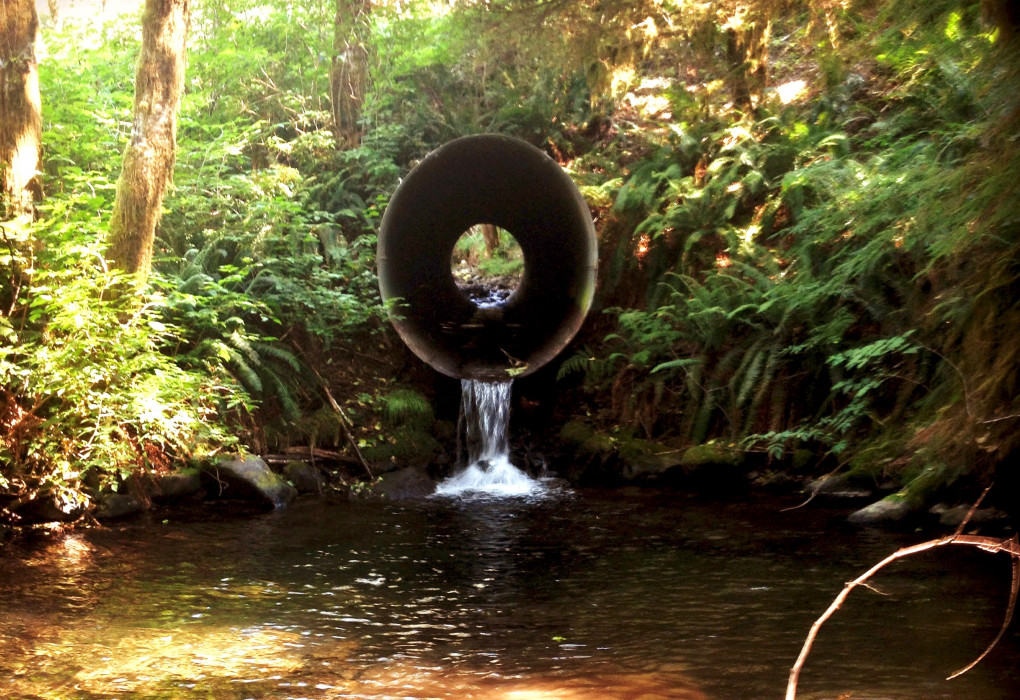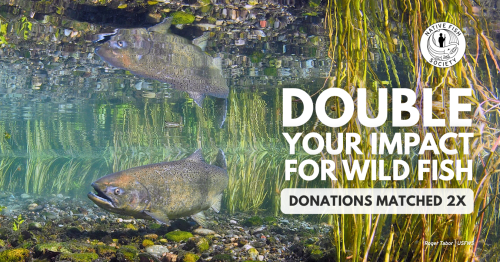Comments on Oregon Department of Transportation Culvert Repair Program


Dear Chair Finley and Members of the Commission,
Please consider the following comments by WaterWatch of Oregon, the Native Fish Society and The Conservation Angler on the proposed renewal of the culvert repair/fish passage agreement between the Oregon Department of Fish and Wildlife (“ODFW”) and the Oregon Department of Transportation (“ODOT”).
In general, while we do not necessarily oppose the program, we believe ODOT should be committing more money to fish passage and that culverts repaired under the program should be required to meet at least some minimum fish passage performance standard – such as providing at least some passage for all affected species every year – in order for a culvert to qualify for the program and not be required to meet full fish passage standards.
This issue is on the Commission’s agenda for December 8, 2017.
ORGANIZATIONS SUBMITTING THESE COMMENTS
WaterWatch is a private, nonprofit river conservation organization founded in 1985 and dedicated to protecting and restoring stream flows in Oregon. WaterWatch also works to protect and restore fish passage in Oregon’s rivers and streams and has led several successful efforts to remove high-profile fish passage barriers, including Savage Rapids Dam, Gold Hill Dam, and Gold Ray Dam.
The Native Fish Society is a private, nonprofit native fish conservation organization founded in 1995 and dedicated to working with local communities to advance science-based solutions to the root causes of native fish declines across the Pacific Northwest. Increasing the connectivity of fish habitats through improved fish passage is a vital component of Oregon's effort to recover and sustain wild, native fish. Native Fish Society staff and River Stewards have participated in fish passage efforts across Oregon including on the Sandy, John Day, Deschutes, Clackamas, Upper Willamette rivers, and numerous coastal systems.
The Conservation Angler advocates for wild fish and fisheries, protecting and conserving wild steelhead, salmon, trout and char throughout their Pacific range. The Conservation Angler is an advocacy organization - holding public agencies, countries and nations accountable for protecting and conserving wild fish for present and future generations - using all legal, administrative and political means necessary to prevent the extinction and to foster a long-term recovery of wild steelhead, salmon, trout and char to fishable and ultimately, harvestable abundance.
OREGON’S FISH PASSAGE LAWS
The basic command of Oregon’s fish passage law is that “a person owning or operating an artificial obstruction may not construct or maintain any artificial obstruction across any waters of this state that are inhabited, or historically inhabited, by native migratory fish without providing passage for native migratory fish.” ORS 509.585(2).
“[N]ative migratory fish” are native fish “that migrate” and are listed in Department rules. ORS 509.580(6). They are not just the fish that go to the ocean and back. They include numerous fish species that migrate entirely within freshwater systems. See OAR 635-412- 0005(32).
Although ORS 509.585(2) prohibits “maintain[ing]” an artificial obstruction without fish passage, the Department’s authority to enforce this law is limited to what are commonly called “triggering” events: “construction, fundamental change in permit status or abandonment.” ORS 509.585(4). “Construction” includes “[m]ajor replacement” and, “[f]or purposes of culverts, installation or replacement of a roadbed or culvert.” ORS 509.580(2). (1)
The statutes do not have specific criteria for fish passage. They direct the Department to do that by rule, which it has. See OAR 635-412-0035. The rules are complex but, in general, they require passage, during the migration seasons of the relevant fish, essentially to the same extent as the surrounding stream allows passage, except at extreme high and low flows. Thus, for road stream crossings, the rules essentially require that the stream go under the road at depths and velocities similar to the surrounding stream, with upstream and downstream connections that don’t prevent passage. OAR 635-412-0035(1)(e) & (3).
The statutes allow the Commission to grant “waivers” and “exemptions.” ORS 509.585(7), (9). However, certain criteria must be met to allow those. A waiver requires mitigation that provides “a net benefit to native migratory fish.” ORS 509.585(7). An exemption requires finding that “lack of fish passage has been effectively mitigated,” or that the commission has granted a “legal waiver,” or that there would be “no appreciable benefit to providing fish passage.” ORS 509.585(9).
ODOT CULVERT REPAIR PROGRAM
In very general terms, the ODOT culvert repair program allows ODOT to repair culverts without meeting full fish passage criteria. Ordinarily, the repair activity would “trigger” the requirement to meet those criteria. OAR 635-412-0020(2) (ODFW enforcement triggered by activities including “construction”); OAR 635-412-0005(9)(d) (defining “construction” for purposes of culverts).
In exchange for not having to comply with fish passage standards, ODOT agrees to make at least some improvement to fish passage at the culverts it repairs, to spend a certain amount of money on fish passage in its own programs, and to pay a specified amount for ODFW to distribute for other fish passage projects.
The culvert repair program was initiated in 2014. It expires at the end of 2017 and is being proposed for renewal in 2018. The existing program operates only west of the Cascades (excluding the North Coast Basin) and cannot include sites considered by ODFW as a “high priority” for fish passage improvements. The proposed renewed program would apply statewide and include barriers identified as a high priority – meaning that those barriers, too, could be repaired without fully complying with fish passage standards – provided that passage at those barriers (which are held to a higher standard) is “significantly” improved, and provided the repairs “address everything possible and necessary at the project site to improve fish passage without replacing the structure itself” (note there no performance standard in terms of how well or how often the culvert must provide fish passage).
COMMENTS ON THE PROPOSED EXTENSION OF THE PROGRAM
We appreciate the good work that has been done under the existing program both to improve fish passage at repaired culverts, even if not to full standards, and to provide full fish passage at other sites with the help of ODOT funds. These projects have no doubt improved conditions for native migratory fish in Oregon.
We understand and appreciate the rationale for this program: To best distribute the limited funds that ODOT says it has available for fish passage. We also understand the contention that, without this program, ODOT will repair far fewer culverts and let many others go unrepaired, and possibly fail, simply to avoid triggering full, expensive fish passage requirements.
However, it is important to recognize that this program allows ODOT to do less for fish passage – probably substantially less – than the law would otherwise require it to do. The very point of the program is to give ODOT a way to not meet fish passage standards – standards the Commission said by rule were necessary to provide adequate upstream and downstream passage for native migratory fish. This point tends to get lost in presentations on the program because the presentations focus on the improvements being made and not on the continuing inadequacies of fish passage at the culverts repaired under the program.
The program may set a bad example. The culvert repair program excuses ODOT from meeting ODFW’s fish passage standards simply because doing so is expensive. Surely it is expensive for everyone. So how does ODFW tell others to comply with fish passage standards if it doesn’t require that even from other agencies of state government? ODFW should be sending the message that fish passage is expensive, but necessary. The culvert repair program tends to undermine that message.
The program may be inconsistent with statute. Oregon’s fish passage statutes require full fish passage upon “construction” (defined by statutes and rules to include culvert repairs) unless the Commission approves a waiver or exemption, both of which have statutory criteria that must be met. No one is applying those criteria here or determining if they are met.2 According to the draft renewal agreement, the legal authority for the program is OAR 635-412- 0020(3)(b), which allows ODFW to grant “programmatic approval of a fish passage plan for multiple artificial obstructions of the same type.”3 (Draft Agreement, I(3).) We read that to authorize approval of multiple similar structures as meeting fish passage criteria, not to authorize a program of non-compliance, which is what the ODOT culvert repair program essentially is. To the extent the rule may plausibly be read otherwise, it may be inconsistent with statute. The fish passage statutes basically provide three options: passage according to criteria established by ODFW, a waiver, or an exemption. We do not think they authorize giving an entire category of obstructions, owned by a particular party, a special exclusion from the fish passage rules without any analysis of whether the exclusion meets the requirements for a waiver or exemption.
ODOT should be required to spend more money on fish passage. Under the proposed extended program, assuming 100 culverts are repaired as expected under the agreement, ODOT would save at least $145 million over the next five years but contribute only $5 million (less than five percent) to the fish passage compensation fund managed by ODFW.4 ODOT would spend a total of approximately $35 million on fish passage over the next five years. (5) While that may sound like a lot, it is less than one percent of ODOT’s highway repair budget. 6 To put things in perspective, ODOT is proposing to spend $450 million to widen just two miles of freeway near Portland7 – more than 10 times what it is proposing to spend statewide on fish passage over the next five years. We think fish passage should be given a higher priority in ODOT’s budget. In Washington, federal courts recently identified impaired fish passage at highway culverts as a top priority for restoring anadromous fish runs and ordered the Washington Department of Transportation to undertake an aggressive program of culvert replacement and repair to comply with treaty obligations giving Native Americans “the right of taking fish, at all usual and accustomed grounds and stations.” United States v. Washington, 853 F.3d 946 (9th Cir. 2017).8
The program should have a minimum fish passage performance standard for culverts to qualify under the program. The draft agreement would require only that passage at repaired culverts be improved somewhat. Improving passage from one day a year to two days a year would be enough. Improvements at “high priority” sites are required to be “significant,” and to “address everything possible and necessary at the project site to improve fish passage without replacing the structure itself” (Section III(2) n. 6), but that does not require any particular degree of passage for fish. “Significant” is subject to a wide range of interpretations, and “everything possible and necessary . . . without replacing the structure” may still leave terrible fish passage. A culvert that fails to provide any meaningful fish passage should not escape full fish passage standards simply by adding one day of passage for one species. The agreement could require, for example, that every culvert at least provide passage some of the time for all affected species and life history stages, or to provide passage over a narrower “design streamflow range” (representing, say, 75 percent of the flows instead of the 90 percent ordinarily required for full compliance). Culverts that cannot meet even the reduced standards should be replaced with stream crossings that fully comply with the Commission’s rules.
Thank you for considering our comments on this important issue.
Sincerely,
Brian Posewitz, Staff Attorney, WaterWatch of Oregon
Mark Sherwood, Executive Director, Native Fish Society
David Moskowitz, Executive Director, The Conservation Angler
(1) The rules define “construction” in even greater detail, including for culverts. OAR 635-412-0005(9)(d).
(2) According to ODFW staff, the culvert repair program is not operating under the criteria for a waiver or an exemption. If it were, there would need to be a finding, supported by substantial evidence: (a) that complying with full fish passage standards at the culverts would not provide an “appreciable benefit” to fish; (b) that lack of full fish passage was “effectively mitigated”; or (c) that the partial improvements to fish passage at the culverts and the funding of other fish passage projects provided a “net benefit” to fish relative to full compliance with fish passage criteria at all repaired culverts.
(3) Although the 2014 agreement also cites this rule, the 2016 Annual Report says the current program “was approved by the Oregon Fish and Wildlife Commission on October 10th 2014 as an ‘other action specifically approved by the Commission’ under Oregon fish passage rules (OAR 635-412-0040(2)d).” (Culvert Repair Programmatic Agreement (CRPA) Annual Report 2016, p. 4.) We do not understand the discrepancy but base our analysis on the authority cited in the agreement. In any event, the rule cited in the annual report simply authorizes other categories of “mitigation” for a waiver and does not, in our view, provide legal authority for ignoring fish passage criteria without making the findings necessary for a waiver or exemption.
(4) The 2016 annual report on the program says ODOT saved $35 million at just six culverts that year. The report says replacing culverts to full fish passage standards generally costs from $1.5 to $5 million per culvert, compared to $50,000 to $150,000 to repair a culvert with some improvement to fish passage. Assuming 100 culverts are repaired as anticipated, that translates to ODOT savings of $145 million to $485 million under the proposed program.
(5) The amount includes $5 million to be paid as compensation for not meeting fish passage requirements at an estimated 100 culverts, $21 million of ODOT spending on its own fish passage programs, and some amount to improve fish passage at the repaired culverts (we estimate $10 million based on estimates of $50,000 to $150,000 to repair a culvert with some improvement to fish passage, which generously assumes all the repair cost is for fish passage).
(6) According to its website, ODOT has a highway division budget of approximately $1 billion per year, or about $5 billion for the term of the proposed fish passage agreement.
(7) http://www.opb.org/news/article/oregon-portland-in...
(8) We do not suggest a specific dollar amount or percentage because we recognize there is no clear formula for this.



